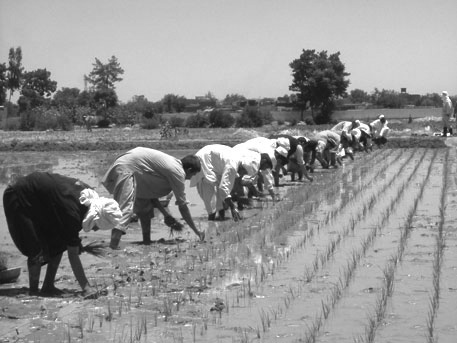Japan's Official Development Assistance White Paper 2010
(3) Food
According to the Food and Agriculture Organization of the United Nations (FAO), the number of undernourished people is estimated to reach about 925 million by the end of 2010, and the goal of halving the proportion of people who suffer from hunger by 2015 set forth in the MDGs is in jeopardy. The need for food supplies is increasing due to factors such as conflicts, natural disasters, and the occurrence of the financial and economic crisis. Furthermore, there is a need for international cooperation for enhancing food security and for multifaceted policies, such as ensuring social safety nets, improving nutrition, improving the supply and demand balance and measures against animal infectious diseases through increasing food production.
<Japan’s Efforts>
Based on the current situation, Japan provides food assistance. In FY2009, Japan gave support totaling ¥14.21 billion of bilateral food assistance to 21 countries. In terms of multilateral food assistance, Japan provides food mainly through the United Nations World Food Programme (WFP) for emergency food assistance, the promotion of education opportunities, and supporting regional social independence. In FY2009, Japan contributed a total of approximately ¥22.1 billion to WFP projects implemented all over the world.
Japan also has been supporting developing countries’ own efforts to enhance food security. Japan reinforces countermeasures for animal infectious diseases that expand beyond national borders, such as foot-and-mouth disease, including the Global Framework for Progressive Control of Transboundary Animal Diseases, by cooperating with the World Organization for Animal Health (OIE), the Food and Agriculture Organization (FAO), and the United Nations.
●For Japan’s efforts in regard to agriculture, see Agricultural Sector Performance on page 61.

Rice planting training conducted by experts and researchers at the Sishanbak Agricultural Experiment Lab (Photo: JICA)
●Uganda: Purchase for Progress
Due to many years of fighting between the Ugandan National Army and antigovernment forces, agricultural production declined significantly in the northern part of Uganda. Here, JICA and the WFP are collaborating to disseminate the cultivation of New Rice for Africa (NERICA). JICA experts provide technical guidance related to rice cultivation to WFP staff and local farmers, while the WFP monitors the cultivation and development status of the NERICA rice. What is more, the WFP provided training to the farmers concerning harvesting, the handling of the rice following the harvest, and storage methods. Through this collaboration with JICA, NERICA rice was cultivated by roughly 2,400 farmers on 2,410 acres of land in 2009. This technical guidance by JICA ties in with Purchase for Progress (P4P), in which the WFP purchases rice produced by small-scale farmers in Uganda and uses it for food support projects like school lunch projects.
